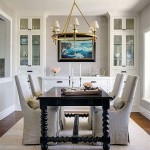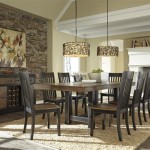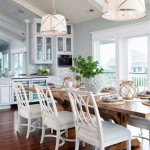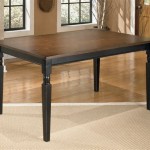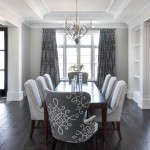The Enduring Appeal of the Dining Room Table with Sideboard Combination
The dining room, historically a central gathering place for families and friends, continues to hold significance in contemporary homes. Within this space, the dining room table and sideboard form a complementary pairing, offering both a practical and aesthetic contribution. This article explores the enduring appeal of this classic combination, examining its functionality, design considerations, and evolving role in modern living.
The dining room is often more than just a place to eat. It can serve as a space for homework, board games, and important conversations. As such, the furniture within this space needs to be both functional and inviting. The dining room table, the focal point of the room, provides a surface for meals and activities, while the sideboard offers storage and display capabilities. This pairing contributes to a well-organized and aesthetically pleasing environment, fostering a sense of comfort and connection.
Functionality and Practicality: The Heart of the Combination
The primary benefit of combining a dining room table with a sideboard lies in its enhanced functionality. The table provides a designated area for dining, while the sideboard addresses the crucial need for storage and serving space. This arrangement contributes to a more organized and efficient dining experience.
Sideboards, also referred to as buffets or credenzas, offer ample storage for dinnerware, silverware, linens, and serving dishes. This storage capacity is particularly valuable in homes with limited kitchen space, allowing for the convenient storage of dining-related items close to where they are needed. By keeping these items readily accessible, the sideboard streamlines meal preparation and serving, reducing clutter and promoting a more relaxed atmosphere.
Beyond storage, sideboards often provide a surface for serving food buffet-style. This is particularly useful during gatherings and holidays, allowing guests to easily access dishes and serve themselves. The sideboard can also serve as a bar area, holding drinks, ice buckets, and cocktail accessories. The versatility of the sideboard extends its practical value far beyond simply storing dinnerware.
Furthermore, the sideboard often features drawers or cabinets that can be used to store tablecloths, napkins, placemats, and other table linens. This dedicated space keeps these items clean and organized, preventing them from being misplaced or wrinkled. The availability of dedicated storage contributes to the overall tidiness of the dining room, enhancing the aesthetic appeal of the space.
The placement of the sideboard in relation to the dining table also contributes to functionality. Ideally, the sideboard should be positioned close enough to the table for easy access to its contents, but far enough away to allow for comfortable movement around the dining area. This strategic placement ensures that the sideboard is a practical asset without being an obstruction.
Design Considerations: Harmony and Style
The aesthetic appeal of the dining room table and sideboard combination is equally important to its functionality. When selecting these pieces, careful consideration should be given to their style, materials, and overall design to ensure that they complement each other and the surrounding décor. A harmonious combination enhances the visual appeal of the dining room and creates a cohesive and inviting atmosphere.
Style is a crucial element in creating a cohesive dining room design. The dining table and sideboard should ideally share a similar aesthetic, whether it be traditional, modern, rustic, or contemporary. Matching the style of these pieces creates a sense of unity and prevents the room from feeling disjointed. For example, a traditional dining table with carved details would pair well with a sideboard featuring similar ornamentation, while a sleek, minimalist table would be best complemented by a sideboard with clean lines and a simple design.
Material selection plays a significant role in both the appearance and durability of the furniture. Wood is a classic choice for dining room furniture, offering warmth and richness. Different wood types, such as oak, maple, cherry, and walnut, offer varying colors and grain patterns, allowing for customization to suit individual preferences. Metal, glass, and stone can also be incorporated into the design, adding a contemporary touch or creating a more industrial aesthetic. The materials used should be durable and easy to maintain, ensuring that the furniture will withstand the rigors of daily use.
Beyond style and materials, the size and proportions of the dining table and sideboard are important considerations. The table should be appropriately sized for the room, allowing for comfortable seating and movement. The sideboard should also be proportionate to the table and the overall space, avoiding a situation where it overwhelms the room or appears too small. Careful measurement and planning are essential to ensure that the furniture fits seamlessly into the dining room.
Color is another key element in creating a harmonious design. The color of the dining table and sideboard should complement each other and the surrounding walls and décor. Neutral colors, such as white, gray, and beige, provide a versatile backdrop that can be easily accented with pops of color. Alternatively, bold colors can be used to create a more dramatic and eye-catching effect. The key is to choose colors that create a cohesive and balanced look.
The Evolving Role in Modern Living: Adaptability and Versatility
While the fundamental purpose of the dining room table and sideboard remains consistent, their role in modern living has evolved to reflect changing lifestyles and design preferences. Today, these pieces are often adapted to serve multiple functions, reflecting the growing trend towards multi-purpose spaces. The adaptability and versatility of the dining room table and sideboard contribute to their continued relevance in contemporary homes.
In smaller homes or apartments, the dining room may be integrated with the living room or kitchen, creating an open-concept living area. In these situations, the dining room table can serve as a workspace, a game table, or a casual seating area. The sideboard can also be adapted to serve multiple functions, such as a media console or a storage unit for living room essentials. This adaptability allows the dining room table and sideboard to seamlessly integrate into multi-purpose spaces.
The rise of remote work has also influenced the role of the dining room table. Many individuals now use the dining table as a temporary or permanent workspace, requiring a comfortable and functional setup. In these cases, the sideboard can be used to store office supplies, files, and other work-related items, keeping the dining table clear and organized. This allows the dining room to transform into a productive workspace without sacrificing its primary function as a dining area.
Furthermore, the dining room table and sideboard can be used to showcase personal style and create a welcoming atmosphere. The sideboard can be styled with decorative objects, such as vases, candles, and artwork, adding a personal touch to the dining room. The table can be adorned with a beautiful centerpiece or a carefully curated tablescape, enhancing the visual appeal of the space. These decorative elements contribute to a more inviting and personalized dining experience.
The increasing popularity of sustainable and eco-friendly design has also influenced the materials and construction of dining room tables and sideboards. Many homeowners are now opting for furniture made from reclaimed wood, recycled materials, or sustainably harvested wood. These choices not only reduce the environmental impact of furniture production but also add a unique character and charm to the dining room. The emphasis on sustainability reflects a growing awareness of environmental issues and a desire to make responsible choices.
The integration of technology into the dining room is another trend that is shaping the role of the dining room table and sideboard. Many modern sideboards now feature built-in charging stations or discreet cable management systems, allowing for the convenient use of electronic devices during meals or gatherings. This integration of technology reflects the increasing reliance on electronic devices in everyday life and the desire to create a seamless and connected dining experience. Additionally, smart lighting systems can be integrated into the dining room to create a specific ambiance for different occasions, controlled via a smartphone or voice assistant.
In conclusion, the dining room table and sideboard combination remains a relevant and valuable addition to modern homes. Its enduring appeal stems from its functionality, aesthetic appeal, and adaptability to changing lifestyles. By carefully considering the style, materials, and proportions of these pieces, homeowners can create a dining room that is both practical and visually appealing, fostering a sense of comfort and connection.

Woodsmith Magazine Dining Room Buffet Plans Woodpeckers

Buyers Guide To Dining Room Sideboards And Buffets Countryside Amish

Woodsmith Magazine Dining Room Buffet Plans Woodpeckers

Whitman Extension Dining Table

Dutchcrafters Amish Lakeland Modern Dining Room Set For 6

1800mm Extendable Dining Table Rectangle Sideboard With Storage Homary

Buyers Guide To Dining Room Sideboards And Buffets Countryside Amish

Dining Room Sideboards Elegant Decorating Ideas

Modern Rustic Extendable Folding Dining Table Rectangle Sideboard With Storage In Walnut Gray

Jasiway Folding Dining Table Sideboard In One With Glass Sliding Doors And Storage Drawers

